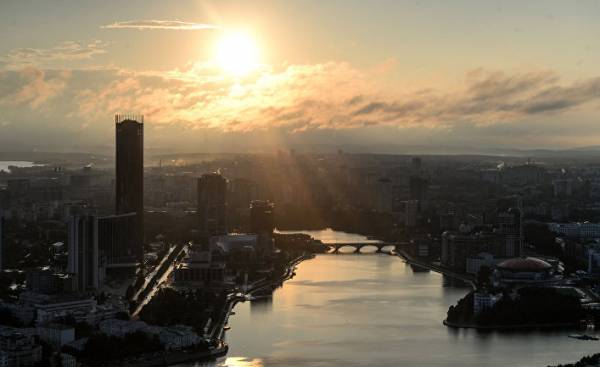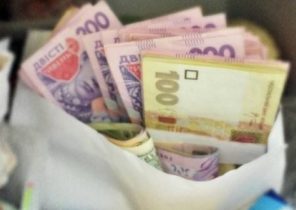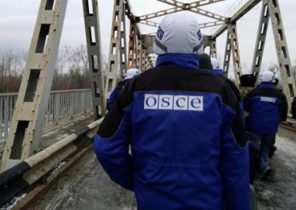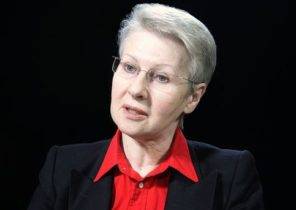
Fifteen hundred people holding hands lined up along the shore of the City pond in the center of Yekaterinburg. The recent civil flashmob “Hug-a-pond” has collected under the banners of citizens, dissatisfied with the construction project of the Church of St. Catherine right in the waters of the pond. The organizers did not initially positioned it as a political, like the anti-corruption protests that on March 26, were held in many Russian cities, including Yekaterinburg. Everything reminded rather of mass celebrations — with children, with smiles and applause each other. And if the first such action in February came only two hundred people, then the April one and a half thousand Russian protest standards — a fairly respectable figure.
Yekaterinburg is not the first time resists the attempt to build up the urban space without taking into account the views of citizens. So, seven years ago, five thousand rally helped defend nearby with a pond area of Work, which at the initiative of the Russian Orthodox Church and former Governor Alexander Misharin was going to restore blown up in the 1930s, the Cathedral of St. Catherine. Then the protest has United both the public and the urban elite, traditionally hostile attitude to the regional authorities. As a result, the project was abandoned, and two years later was removed from his post himself Misharin, whose place was taken by Putin’s new protégé Yevgeny Kuyvashev.
Today, however, the situation was more complicated: the active part of the citizens were left alone with the Union of regional oligarchs, the authorities and the Church, and to protect have the only open space in the city centre and only — along with the city dam — an object surviving from the time of the founding of the city in 1723. In addition, the city administration, having lost last year the town planning authority, cannot prevent the implementation of the plan.
The Church as a gift
That pond is going to build the temple in the unusual city old Russian style, was announced at the city’s popular portal e1.ru.
In February 2016, published the first note about the project, and on March 29 came a detailed review of the project with thumbnails and videos. The public, accustomed to the various insane and the media hangs in the air ideas, not reacted to the news seriously. As says the political scientist and one of the organizers of the action “Hug-a-pond” Dmitry Moskvin, these “piping work so that most people people moved away from issues like from the stories”.
“To build on the water temple with a height of 66 meters — it is simply to kill the pond and turn it into a puddle.” Source: E1.EN.17 Oct 2016 was presented the final draft with the models from the architect and Professor of Architectural Academy Michael Golubitskogo soon approved by the town planning Board under the Governor. Although so far, except for this recommendation, no official documents, no, the opponents of the building of the pond have no doubt that through all the bureaucratic procedures until the final signature of the Governor, the project will be easy — simply because the project obviously pushed from the top.
Unlike 2010, the initiative of the construction comes not from the Church and the Governor, and big business oligarchs Igor Altushkin and Kozitsyn Andrei, owners of Russian copper company (RMK) Ural mining and metallurgical company (UMMC), respectively. Both of the businessman in the middle of the zero was restored destroyed in 30-s of the temple “Big Chrysostom” in the center of Yekaterinburg, however, if this recovery looked even optional, but more or less a friendly gesture, the project of the temple on an artificial island in a single pond in the center of the city is more like a bad joke, which, however, very much a current Governor Kuyvashev.
There are several versions of events, each of which may find its supporters. One of the most rational is a business owner’s ambition RMK Altushkin. It tells the newspaper, “all enterprises Altushkin are in the neighboring Chelyabinsk region, so it is strange that he’s coming here to the temple. But now he has a big problem with the construction of a mining and processing plant, which can cause enormous damage to the environment. In Chelyabinsk all have been excited, and he needs to push the construction from above. The only lever on top, which have Altushkin is the Patriarch. The temple thus becomes a gift to the Patriarch, who would have talked to some lobbyists in Moscow.”
According to Moskvina, at the moment it is the only rational version, although it does not fully explain why the construction of the temple should be the Governor.
Another version, according to Moskvina, is that “Altushkin and Kozitsyn are the main sponsors of the election campaign extremely unpopular Governor Kuyvasheva, and the Church is a gift from the past. But this is a strange gift for their sponsorship. Usually give a enterprise or even company towns, and here only the temple and a lot of problems.” Meanwhile, to direct gubernatorial elections (in the Sverdlovsk region, the first in 14 years) is less than six months — they are scheduled for 10 September, and although the exact composition of members is unknown, in part Kuyvasheva media no doubt.
His nomination for Governor was announced by the mayor of Yekaterinburg Yevgeny Roizman, who in an interview for openDemocracy Russia on the theme of the temple spoke rather vaguely: “the Project is cool, but people need to talk.” Roizman is confident that the initiative Altushkin and Kozitsyn, there is no political motive. In his opinion, “this is a personal hot personal desire Altushkin, who was supported by Andrei Kozitsyn” and which can be explained rather by a sincere belief in God, rather than business interests.
The situation is compounded by the impotence of the city administration. In 2016 between the city and oblast who are at odds since the 90’s, came to a temporary truce, associated with the transition of the former Vice-mayor of Yekaterinburg Vladimir Tungusov for the position of head of administration of the Governor. In the same year the city was selected by the urban planning authority, so that the final point on the question of the construction of the temple can only put the Governor.
However, this potentially puts him in a difficult position. According to Roizman, “everything goes to the fact that the temple will be perceived as the Governor’s project. The Governor is now in a very difficult situation: he made promises and he has some agreement”.
“If there will build the temple, no UNESCO will never happen here”
Although the local diocese is the initiator of the project, it would be strange to expect from it a waiver of such luxury gift as the temple in the center of Yekaterinburg. However, as noted by the newspaper, the Church maintains a pause, “she has no prayer in 2010-m to year, and there is no internal PR. This is evident in our dialogue with the Orthodox activists, some of which are against the construction as it is, in their opinion, makes a split case and denigrates the Orthodox Church.”
That in the Orthodox ranks there is no unity on this issue, says at least that fact, then share “Hug-a-pond” came out including former seminarians, not to mention ordinary believers. The Church, according to and Moskvina, and Roizman, role in this case is secondary: she was just faced with the fact that she will present to the Church in the waters of the pond.
The Committee for the protection of the pond
A group of opponents of the construction of the pond was formed December 7, 2016. Then about 40 people — mostly architects, designers, sociologists, and philosophers gathered at a round table organised by the independent Centre for applied urbanism, which created a Committee of city pond. Committee members initially said they are not against the temple itself (and therefore the Church), and against building anything in the waters of the pond.
The arguments of the Committee and its supporters can be divided into urbanistskaya and political. In the first case, it is emphasized that the pond is an important symbol of the city. As noted Moskvin, “the pond and the dam is the only thing that has remained since the construction of the city. To the 300 anniversary we come only with these two objects of memory. For us this whole complex that you want to protect, and who has a chance to be taken under the protection of UNESCO. To build on the water temple with a height of 66 meters — it is simply to kill the pond and turn it into a puddle.”
In addition, Ekaterinburg is one of the world capitals of constructivism, and the building on the selected location simply destroy the constructivist complex of the stadium “Dynamo” — unique from the monuments of constructivism, which may be of interest to UNESCO. As a UNESCO site, a Dynamo would have to be under the state protection in accordance with international requirements, but “if there will build the temple, no UNESCO will never happen here”, emphasizes the newspaper.
Ekaterinburg — one of the world capitals of constructivism. SS BY-2.0 Anton Novoselov. Some rights reserved. No less significant is the political argument, namely that the Church is imposed from above the object, which was approved without taking into account the views of citizens. According to Roizman, this is the main reason for the discontent. “Someone decided something and no one asked. People said if you, the oligarchs, gathered themselves all up, then we who are in your city? In Yekaterinburg decided to talk to people. If the company something not support, then this will have to be.” He Roizman feels the role of a mediator between civil society and the developer, emphasizing the “coolness” of the project, but noting that he “never said that the chosen location is very good”.
This is obviously the side of the Builder, in principle, is not going to enter the dialogue, limited to slogans that the temple is a gift to the city, which will attract tourists. “I am constantly asked to provide graphs and tables showing how to change the number of tourists and the amount of money for the city it will give, but nothing like this,” says Moskvin.
A God on earth
The most zealous defender of the temple is its architect Michael Goloborodsky, which at one time was among the opponents of the Church in the square of Labour.
According to him, the choice of location in the water area of the pond is dictated by the fact that the main Cathedral as “evidence of the real presence of God on earth must be the center of the city on open space and to be as to perceive.” Although historically the churches in Russia were built at higher elevations, according to Golubitskogo Ekaterinburg with its landscape in the form of a bowl may be an exception. “Here, everything is perceived from the top down. Therefore, the pond is the only winning place,” he said in an interview for openDemocracy.
According to Golubitskogo, that in Yekaterinburg is the Church of St. Catherine, is an obvious paradox that needs to be corrected. Besides, in the city of the main Cathedral Church, and today Cathedral is too small: “when is a service with the Bishop, is going to a lot of people.” However, “a lot of people” — the wording is more than vague.
According to police statistics, on palm Sunday the next day after a protest across the region in churches came only 30 thousand people, while the population of Yekaterinburg only one and a half million. The active congregation is only 2-3% of inhabitants of the city, and to this fact appealing and came to protest the believers — the occupancy of the temples in the city center is too small, while in some densely populated residential areas, churches at all.
“Active flock represents only 2-3 percent of the residents of the city”
That 66-foot Church will spoil the historical appearance of the pond and the arrows of the stadium “Dynamo”, Goloborodsky denies, citing the fact that the Dynamo “has crushed skyscrapers, and now it’s a pygmy, which is not visible”. As for concerns about a mutilated view of the pond, according to the architect, the temple is only a “little piece of backwater, which has no effect”, and the height of the Cathedral is necessary to define the upper ledge of the main part — in this case, it is 22 meters. Where will disappear from view additional 40 meters, Goloborodsky did not specify.
When it comes to the fact that the project was launched from the top down without even the semblance of dialogue with the citizens, Goloborodsky retorted with a quote from the gospel: “Many are called, but few are chosen. The city is constantly changing. Did you set up the public about skyscrapers? Temples supposedly imposed, and against the offices no one speaks. Not the choice of the land for the Cathedral to be treated on the principle of “for you, o God, that we are worthless”. In his opinion, all the outrage is “not concerned about where the Cathedral will stand, and the excuse for it did not exist”. Although anti-clerical motives of many of the protesters cannot be ruled out, the main aim of the protesters is still the preservation of the historic pond.
The city as a value
Disputes around the temple actually represent two neoclasica with each other approach to history and historical memory.
In the case of developers working not only the logic of imposing one approved by the authorities of the interest, but also artificial, not backed by history of designing urban identity. Many questions were provoked by the appearance of the Church: like the Church of the Savior on blood in St. Petersburg, it should be executed in pseudo-Russian style, copying the decoration of the Cathedral of Vasily the blessed on red Square. According to Roizman, “this will be the third Cathedral of this kind, and the task of those who invented it, to show that Ekaterinburg — the third capital”.
Goloborodsky goes further: despite the fact that Ekaterinburg was founded by Peter I in 1723, to build the temple in the Petrovsky style, in his opinion, impossible.
He stressed that “Peter’s relationship to the Church is difficult because Peter had deprived Russia of the Patriarch and subordinated the Church to the Synod of bishops with the secular administration. He humiliated the Church, so no reference to Peter’s time in architecture”. XVII century, he said, is “the period of formation of national consciousness,” and the architecture of the era “showed the joyful character of the time of the reign of the Romanovs.”
Thus, the temple, referring to the pre-Petrine era, put at the service of artificially implanted a national myth, while the real history of the city associated with a pond as part of the factory of the past and with Soviet constructivism, in fact destroyed.
The constructivist heritage of the city until recently in the public consciousness generally poorly perceived as heritage, but in the last couple of years the situation began to change. This is largely due to the activities of a group of researchers, members of the Committee of the city pond: Larissa Piskunova, Igor Yankov and Lyudmila Starostvos — anthropologists, studying the architectural past of the city through the stories of its inhabitants.
Through excursions, exhibitions and lectures, they try to explain the maximum number of residents to the aesthetic codes of constructivism and tell about the uniqueness of Yekaterinburg buildings. Says in an interview Piskunova, the peculiarity of Ekaterinburg that are able to implement constructivist entire ensembles, not just individual buildings, as in Moscow.
It is also about “powerful intelligent design” lies in “building new life for a new man in the era of the lack of technology and materials.” As for the main “victim” of a possible construction of the sports complex “Dynamo” — “a unique architectural structure unique to the 1930-ies the filling: the city’s first indoor swimming pool with towers for diving, skating rink for training skaters. The complex gave the opportunity for children and athletes to train on the Federal level.”
What do Piskunova, Yankov and Starosta is an attempt to discuss the historical heritage and the formation of urban identity “from below”, that is the complete antithesis of the draft Golubitskogo and business. Yankov says, “when we are engaged in constructivism, one of the objectives — work with the Soviet experience, and uncovering the multidimensional potential of the city. While we are just entering the stage of awareness of his past, and the struggle for the pond is very revealing — we have not realized its importance. The city should be valued, and for the oligarchs is a resource and a source of income.”
The struggle continues
Yet each of the parties involved in their business. Goloborodsky details considering the composition and working on engineering issues — he recently said that the area of pond construction you will still have to drain. The main strategy of the Committee was to inform the maximum number of citizens and conducting public campaigns.
Despite the success of the recent flash mob, the main struggle is still ahead. Says Roizman, “the developers have enough resources to bring 25 thousand people”, that kind of happened at Easter, when the procession, headed by the Governor and the Metropolitan changed the usual route and reached the site of the proposed construction. For its part, Moskvin says he is ready to go to rallies and pickets in the case of the final signed building permit. Besides, the visible protests in the regions often attract the presidential administration, which, as in the case of the transfer of the Church of St. Isaac’s Cathedral in Saint-Petersburg can straighten presumptuous of the Governor.
As is generally accepted in Russia, the main factor allowing for abuse of power, is fragmented passivity of the population in their daily business and pay little attention to their living environment. At the same time I want to play and developers: Goloborodsky openly says that “very many people this story does not care. They live their lives, and it makes no difference what’s going on here”. The task of the opponents in this case — to fill the information space and to activate all available resources to ultimately the project was abandoned.
According to Moskvina, “the end of summer 2018 construction is unlikely to start because of the world Cup. Time is on our side, so we are trying to engage in a fight the maximum number of people and saying to the authorities: guys, think again”.






